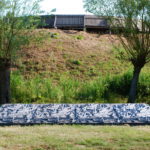Kunstintegratie in archeologische site
Opdrachtgever: gemeente Ertvelde
Locatie: Site “De Motte”, Ertvelde
Realisatie: 2010
Materiaal: Architecturaal beton
Fotografie: Hans De Pelsmacker
Om het landschap zo ongeschonden mogelijk te houden is het ontwerp een laag en vlak platform van 4m x 4m en 40 cm hoog dat vooral bestaat uit afgietsels van echte takken en snoeihout. Hierdoor wordt het ontwerp een natuurlijk element in het landschap zoals een struik of een haag. De takkenstructuur verloopt van grondniveau tot zithoogte en evolueert naar een zuiver vlakke vorm waarop men kan zitten; om verwonderd te kijken naar een vreemde nederzetting van weleer. Het ontwerp wordt pas in zijn totaliteit zichtbaar wanneer de Motte niet zichtbaar is: namelijk wanneer de toeschouwer boven op de Motte zelf staat. Vanuit de hoogte en afstand is de volledige vorm en de specifieke plaatsing van het ontwerp in het landschap zichtbaar. Het ontwerp wordt zo geplaatst dat het een bepaalde richting aanduidt met betrekking tot een windrichting en/of plaats. Het lichtelement kan die richting benadrukken en geeft het ontwerp bij duisternis een andere identiteit.
In the sports and recreation resort Hoge Wal in Ertvelde there is a site on which the Count of Flanders had a little fortified castle built in the 11th century. It was situated on an artificial and walled hill. The hill – called ‘the Motte’ – and the walls still exist today and are protected as historical landscape. The municipality of Evergem asked to create a design that “forms a dialogue between the Motte and the visitors of the resort”. The Motte has an unusual, unnatural form and place in the landscape of which it is still part after centuries. The concept for this functional design has grown from my first contact with this site. My experience was ‘looking in amazement’. Another observation was the dynamics of the location: a lot of joggers, playing children and walkers.






